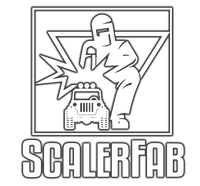Soldering - A ScalerFab Team Driver Tutorial
ScalerFab Tech Tip – June 2017 by
Oliver Barber
Soldering Basics
Soldering is a pretty simple and extremely useful skill within the RC hobby, however, over time, I've come across a fair number of people who don’t believe they can do it. Instead opt to pay a hobby shop or fellow hobbyist to solder for them.
This guide aims to show that soldering things yourself is an extremely simple, more convenient, and much cheaper way, than paying someone else, to do it. I’ll be making a ESC-battery extension lead as an example.
Stuff you will need

- Decent soldering iron (I have a Weller SPG 40, and like it a lot) – an underpowered iron won’t fully heat up the solder; ideally you want to touch the solder and have it instantly melt.
- Side cutters – useful for cutting wires to length
- Hobby knife – for stripping rubber sheathing from the wires.
- Flux – Makes the solder bond much more easily to wires. Most brands designed for electronic soldering are pretty good.
- Solder - aim for a mix that’s close to a 60/40 mix of tin and lead.
- Electrical tape – for covering wires when done, pretty self-explanatory.
- What you want to solder - esc needing connectors, LEDs, etc.
Step 1
Strip the wire(s) you’ll be soldering with the hobby knife. You want to aim to just remove the rubber coating without cutting into the wire strands inside too much. In most cases, you’ll want to remove at most 6mm (1/4in) of coating from the end.

Step 2
Coat everything that is going to be soldered with flux. I typically use an old paintbrush that I have lying around for this; you just want to aim to have a light coating. Any more will just result it running all over the place when it melts and becomes a liquid later.

Step 3
Turn your soldering iron on, wait for it to heat up, then melt some solder onto the tip. Touch the iron to one of the wires you’re working with, until you see that it has wicked the solder on and into the wire. You may need to rotate the wire a little to ensure full coverage, but the solder will flow of its own accord – if you have to force it, your iron’s temperature is too low. Repeat this for every piece you’re soldering, including connectors. The end result should look similar to the picture.

Step 4
Now, it’s time to actually solder things together! In this case, I held things together by hand, as I was using very stiff wires, but in many cases it may be easier to gently clamp the connector/esc/whatever in a vice, so you have one less thing to worry about.
Hold the wire so it’s touching the connector (with XT60 connectors, the end actually goes into the connector a little), and hold the soldering iron to the joint until you see the solder melt. Remove the iron, and carefully hold everything in place for a few seconds until it hardens fully.

Step 6
All that’s left now is to cover up the bare joint to prevent something causing a short. Both electrical tape and heat-shrink tubing are great for this; I prefer heat-shrink when possible, but had run out before making this guide. If you’re using electrical tape, you’ll only need a piece that’s about an inch long for each wire; anymore and you’ll just be wrapping it around itself multiple times and making everything bulkier for no reason.

That’s it! So long as you do the prep work in the first few steps (flux and tinning), you’re basically guaranteed to get a good solder joint every time. If you’re not sure that a joint is solid, just try to pull on it; if you can’t get it apart by hand, it’ll be fine (obviously be careful if doing this with soldered LEDs).
Quick note: Soldering also works great for creating brass flatbeds, accessories, etc.; just be sure to use a lot of flux and solder, and keep in mind that it’ll take longer for the solder to heat up, as the brass acts like a heatsink.


Leave a comment